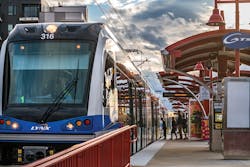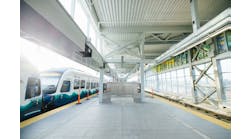Ten years after it was proposed, the 9.3-mile extension of Charlotte Area Transit Systems’ (CATS) LYNX Blue Line opened to riders this March, providing a direct light rail connection from Uptown Charlotte to the main campus of University of North Carolina-Charlotte.
The extension, built at a cost of $1.2 billion, stretches the line out to 18.9 miles in total. The extension added 11 new stations to the line, for a total of 26. Ridership on the line jumped 48% when the extension began service, according to CATS.
“Ridership numbers demonstrate the community’s acceptance and desire for increased transit options as an alternative to traffic congestion,” said John Lewis, CATS CEO.
The original segment of the LYNX Blue Line opened in 2007. “Much of the traffic coming into Uptown comes from the north on two major roads,” said Brian Stover, HNTB construction manager for horizontal work on the extension project. “They were continually backed up and congested. Connecting the neighborhoods of north Charlotte to Uptown was sorely needed.”
Optimal design and construction
Jill Brim, director of the LYNX Blue Line Extension project and senior engineer for CATS, said the extension was designed for safety, convenience and reliability.
“Our riders value on-time performance,” Brim said. “We have many grade separations and many bridges that we’ve added on the extension to separate us from traffic.”
Brim said grades are separated at all the major street intersections along the extension route. “We also separated grades where we crossed over a freight railroad, which was a very exciting piece of construction. They brought in some very large cranes to do that, some of the largest in the country.”
Innovative design was employed to extend the rail line and add a station inside the campus of UNC-Charlotte, Brim said. “The university coordinated with us. We entered through a cut-and-cover tunnel that was kept very short, so we were able to minimize regulatory impacts. This provides a link for students.”
The extension project led to an updated design and reconstruction of North Tryon Street into a more complete thoroughfare. “The transit system is now in the median,” Brim said. “The street includes two lanes in each direction for vehicles, bicycle lanes for a 4-mile section on both sides, grass parkways with trees, pedestrian lighting and sidewalks on both sides of the thoroughfare for the entire distance. We built it as a complete street as part of a larger transportation system.”
The project also included construction of abutments at 36th Street for a future high-speed rail bridge, Brim said.
Challenges and innovative solutions
The extension of CATS LYNX Blue Line bumped up against several obstacles before it reached its destination.
When Stover started working on the extension in August 2014, he learned that a delay in utility relocation threatened to set the project back by about a year.
“That was the first major hurdle,” he said. “We accelerated one of the contractors working along Tryon Street, and we re-sequenced the contractor’s work to allow us to get started in the track area earlier. That got us back on schedule.”
The complexity of the project presented additional challenges.
“There were two civil construction contracts,” Stover said. “The 9.3 miles was divided into two. Then there was a station-finish contract. And at the same time there was a track and systems contractor. The track and systems contractor could not start until the civil construction contractors had the track bed ready for them. When the civil contractors got delayed, those delays translated to the stations contractor and the track and systems contractor.”
As was the case with the work along North Tryon Street, the solution that solved the problem was re-sequencing, Stover said. “We gave the track and systems contractor stretches of a couple of miles to work on as the civil areas were being finished.”
The same solution was applied to the stations contractor, Stover said. “We sequenced their station construction in such a way that was most beneficial for the track contractor. It was a matter of re-sequencing all the contractors.”
Another challenge surfaced when Norfolk Southern Railway had to relocate about a mile of track to make way for the Blue Line extension, Stover said.
“The project was behind in getting the area ready for the railroad to relocate,” Stover said. “We collaborated with Jill Brim from CATS and came up with a workaround plan. We got a concession from the railroad to allow us to build our track within their track envelope, which they normally don’t allow, which enabled completion and revenue service to begin. That problem would have set this project back two years if a workaround plan hadn’t been enacted.”
Stover said issues with track and systems contracting work created a hurdle for its scheduled March 2018 opening date, but an innovative solution was found.
“We broke our testing up into phases that we called breakouts,” he recalled. “Normally you would finish the entire line and test the entire line. In this case, if they weren’t ready in all areas, we allowed them to test [completed] sections of the line as they were finishing other parts of the line, which enabled us to end up meeting our revenue operations date.”
It is not unusual for challenges and obstacles to surface on a big transit project, according to Stover. “Two weeks before we were scheduled to open, a switch in the signal system failed and all the traffic crossing gates went down in fail-safe mode during rush hour,” he said. “Unexpectedly, every gate on this project, over 100, all went down.”
The gate closures were due to a switch configuration issue, Stover explained. “There are 33 switches in the network. One of them is a master switch. If there’s a break in the network, the master switch will feed two ways. There ended up being two breaks in the system and everything went into fail-safe mode.”
The track and systems contractor fixed the switch problem in time for the extension to open on schedule, Stover said.
Collaboration, communication
Looking back on the challenges that were met and the hurdles that were cleared on the extension of the LYNX Blue Line, Stover said that “figuring out how to do it is one thing. Getting everybody’s buy-in, because it wasn’t the normal way they were used to building, commissioning, and testing a system—that was very difficult.”
The challenges could not have been met without close collaboration among CATS, HNTB and all partners, Stover said.
“HNTB brought in experts in commissioning and communication and signal work. They would look at the plan that we were putting together with the contractor, validate it, give comments and determine exactly how it was going to be done. The transit world is a small world. The people we brought in were known by the CATS operations people. They relied on and listened to them about how this could be done. At the end of the day, it did all work out.”
Cathie Farroll, who served as HNTB’s construction communication manager on the project, noted that the project involved 17 contracts. “Each of them has a contractor, who often has subcontractors. They have differing needs. Obviously, the project team has to be in very close communication.”
Farroll said a construction communication strategy was built on close collaboration.
“We worked very closely with our clients, because CATS had a very robust communication team,” she said. “They had multiple ways to get information out to the community, between social media and regular electronic media and newspapers. We made sure they always had the advance notice that needed to go out to the public.”
The communications team also put out a daily e-mail blast to first responders, transportation services and other city agencies that use the roads, to tell them about project-related traffic impacts expected that day.
“In the course of construction, there are always times when things don’t go as planned,” Farroll said. “Sometimes you start to excavate to build a foundation, and you find some underground structure that wasn’t in the plan. You don’t know what it is, so everything has to stop. You have to determine what it is, and how we’re going to get this thing out of the way. A lot of coordination has to come into play.”
Farroll recommended that construction communication managers on major ground transportation projects establish strong communications with first responders and school districts, as well as the business community.
“Many businesses have specific transportation needs,” she said. “They may have large truck deliveries or constant traffic 24 hours a day. You have to evaluate the parcels that are affected and make sure the plans include how we continue to keep traffic going in and out of those businesses.”
Farroll said it is important to find out what businesses need, and then find a way to accommodate that within the contractors’ practices. “CATS had an individual identified as a business liaison, and we worked closely with that person, going out and talking with those businesses. We made sure they knew how to find the information that was available electronically, got them on a mailing list for information, and involved them in quarterly briefings.”
The communications team also developed a set of tips to help businesses share relevant construction-related information with their customers and employees. “We taught them how to be positive about the construction project,” Farroll said. “If you say it’s going to be an improvement for the community, you’re seen as a business that’s in the know, and in an up-and-coming area that’s getting improvements.”
Effective communication on a project such as the LYNX Blue Line Extension requires a proactive stance, Farroll said. “If you tell people in advance of a challenge or inconvenience they will forgive you, because you’ve given them the information while they still have time to plan for the difficulty. If you surprise them with an inconvenience, like a road closure or detour, they’re going to be unhappy with you. Advance notice that’s accurate, and close enough in time that they’ll remember it, is your most important tool in construction communication.”
The LYNX Blue Line extension was conceived as a complete streets project, as part of a larger transportation system.
The vision comes to life
The work, innovation and coordination that went into the extension of the LYNX Blue Line has given Charlotte a vastly improved transportation network.
CATS expects the extension to nearly double ridership on the LYNX Blue Line by 2035. “CATS continues our commitment to enhancing transit services in the region and looks forward to expanding transit options in the future,” Lewis said.
In addition, CATS said the extension has spurred nearly $500 million in projects completed, planned or under construction, and the extension’s total economic development impact is expected to hit $4.4 billion by 2035.
Everyone who played a part in the CATS LYNX Blue Line Extension project can take pride in what was accomplished and how it was executed.
“To see what transit does for communities is one of the main reasons I do this,” said Stover. “It is a wonderful feeling to see it and see the vision come to life.”
Platform-based ticketing makes Blue Line access readily available.



